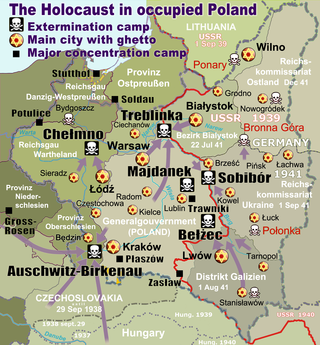
The Second Polish Republic, at the time officially known as the Republic of Poland, was a country in Central and Eastern Europe that existed between 7 October 1918 and 6 October 1939. The state was established in the final stage of World War I. The Second Republic ceased to exist in 1939, after Poland was invaded by Nazi Germany, the Soviet Union, and the Slovak Republic, marking the beginning of the European theatre of the Second World War. The Polish government-in-exile was established in Paris and later London after the fall of France in 1940.

Józef Klemens Piłsudski[a] was a Polish statesman who served as the Chief of State (1918–1922) and first Marshal of Poland. In the aftermath of World War I, he became an increasingly dominant figure in Polish politics and exerted significant influence on shaping the country's foreign policy. Piłsudski is viewed as a father of the Second Polish Republic, which was re-established in 1918, 123 years after the final partition of Poland in 1795, and was considered de facto leader (1926–1935) of the Second Republic as the Minister of Military Affairs.
The history of Poland from 1939 to 1945 encompasses primarily the period from the invasion of Poland by Nazi Germany and the Soviet Union to the end of World War II. Following the German–Soviet non-aggression pact, Poland was invaded by Nazi Germany on 1 September 1939 and by the Soviet Union on 17 September. The campaigns ended in early October with Germany and the Soviet Union dividing and annexing the whole of Poland. After the Axis attack on the Soviet Union in the summer of 1941, the entirety of Poland was occupied by Germany, which proceeded to advance its racial and genocidal policies across Poland.

Pinsk is a city in Brest Region, Belarus. It serves as the administrative center of Pinsk District, though it is administratively separated from the district. It is located in the historical region of Polesia, at the confluence of the Pina River and the Pripyat River. The region was known as the Pinsk Marshes and is southwest of Minsk. As of 2024, it has a population of 124,295.

The 1920 Kiev offensive was a major part of the Polish–Soviet War. It was an attempt by the armed forces of the recently established Second Polish Republic led by Józef Piłsudski, in alliance with the Ukrainian People's Republic led by Symon Petliura, to seize the territories of modern-day Ukraine which mostly fell under Soviet control after the October Revolution as the Ukrainian Soviet Socialist Republic.

Stanisław Bułak-Bałachowicz was a Polish-Belarusian general and veteran of World War I, the Russian Civil War, Estonian War of Independence, Polish-Soviet War, and the Invasion of Poland at the start of World War II. He is remembered as a national hero of the Belarusian opposition and of the Belarusian minority in Poland.

Ivanava is a town in Brest Region, Belarus. It serves as the administrative center of Ivanava District. As of 2024, it has a population of 16,172.

Brigadier General Mieczysław Makary Smorawiński (1893–1940), was a Polish military commander and officer of the Polish Army. He was one of the Polish generals identified by forensic scientists of the Katyn Commission as the victim of the Soviet Katyn massacre of 1940.

Operation Mińsk was a military offensive of the Polish Army during the Polish–Soviet War. It resulted in the capture of Minsk from the Red Army around 8 August 1919. The victory allowed the Polish troops to advance further into Russian-controlled Lithuania and Belarus and thus to present the Bolsheviks with a military fait accompli. The main Polish attack was toward Maladzyechna, Minsk, and Polotsk along the railroad lines. On 6 August, the Polish Army took over Slutsk and Minsk was taken two days later. The Polish units fought under command of General Stanisław Szeptycki. Polish control over the railway lines prevented the Russians from bringing in reinforcements. By the end of August, the Polish forces had taken Barysaw and Babruysk.

The Vilna offensive was a campaign of the Polish–Soviet War of 1919–1921. The Polish army launched an offensive on April 16, 1919, to take Vilnius from the Red Army. After three days of street fighting from April 19–21, the city was captured by Polish forces, causing the Red Army to retreat. During the offensive, the Poles also succeeded in securing the nearby cities of Lida, Pinsk, Navahrudak, and Baranovichi.

The Pinsk massacre was the mass execution of thirty-five Jewish residents of Pinsk on April 5, 1919, by the Polish Army. The Polish commander "sought to terrorize the Jewish population" after claiming to being warned by two Jewish soldiers about a possible Bolshevik uprising. The event occurred during the opening stages of the Polish–Soviet War, after the Polish Army had captured Pinsk. The Jews who were executed had been arrested while meeting in a Zionist center to discuss the distribution of American relief aid; the meeting was described by the Poles as an "illegal gathering". The Polish officer-in-charge ordered the summary execution of the meeting participants without trial, and based on the information about the gathering's purpose that was founded on hearsay. The officer's decision was defended by high-ranking Polish military officers, but was widely criticized by international public opinion.
The Morgenthau report, officially the Report of the Mission of the United States to Poland, was a report compiled by Henry Morgenthau, Sr., as member of the "Mission of the United States to Poland" which was appointed by the American Commission to Negotiate Peace formed by President Woodrow Wilson in the aftermath of World War I. The purpose of the mission was to investigate "alleged Polish pogroms" and the "treatment of the Jewish people" in Poland. The mission consisted of three American members: former US ambassador Henry Morgenthau, Brigadier General Edgar Jadwin of Engineer Corps, and professor of law Homer H. Johnson from Cleveland; and from the British side Sir Stuart M. Samuel. They were selected to investigate accounts of mistreatment of Jews in the newly-reborn Second Polish Republic. The report by Morgenthau was published on October 3, 1919.

Aleksander Narbutt-Łuczyński was a Polish lawyer and military officer, a brigadier general of the Polish Army and a veteran of both the Polish-Bolshevik War and World War II. During the German-Soviet invasion of Poland in 1939 he commanded the rear troops of the Kraków Army.

The 9th Infantry Division was a unit of the Polish Army in the Second Polish Republic. For most of 1919, the 9th Division's regiments were dispersed across the regions of Podlachia, Polesie and Volhynia, with one battalion sent to Dąbrowa Basin.
During the Polish–Soviet War fought from February 1919 to October 1920 between Soviet Russia and the Second Polish Republic – in the aftermath of World War I in Europe – the Polish order of battle included broad disposition of personnel, strength, organization, and command structure.
The Battle of Lida took place on 16 and 17 April 1919 around the city of Lida during the Polish–Soviet War of 1919–20. During World War I Lida was occupied by the German troops. In 1919 the Red Army briefly established Soviet power here.

The Pińsk Ghetto was a Nazi ghetto created by Nazi Germany for the confinement of Jews living in the city of Pińsk, Western Belarus. Pińsk, located in eastern Poland, was occupied by the Red Army in 1939 and incorporated into the Byelorussian SSR. The city was captured by the Wehrmacht in Operation Barbarossa in July 1941; it was incorporated into the German Reichskommissariat Ukraine in autumn of 1941.

Bronna Góra is the name of a secluded area in present-day Belarus where mass killings of Polish Jews were carried out by Nazi Germany during World War II. The location was part of the eastern half of occupied Poland, which had been invaded by the Soviet Union in 1939 in agreement with Germany, and two years later captured by the Wehrmacht in Operation Barbarossa. It is estimated that from May 1942 until November of that year, during the most deadly phase of the Holocaust in Poland, some 50,000 Jews were murdered at Bronna Góra forest in death pits. The victims were transported there in Holocaust trains from Nazi ghettos, including from the Brześć Ghetto and the Pińsk Ghetto, and from the ghettos in the surrounding area, as well as from Reichskommissariat Ostland.

{{Infobox military conflict | conflict = Battle of Pinsk | place = near Pinsk, Civil Administration of the Eastern Lands | partof = Polish-Soviet War | image = Bitwa pinsk 1919.png | image_size = 315px | date = 23 February – 5 March 1919 | combatant2 = Russian SFSR | combatant1 = Second Polish Republic | width = 315px | combatants_header = Belligerents | result = Polish victory | commander1 [[File:Flag of Poland (1928–1980 General Józef Haller [File:Flag of the Russian Soviet Federative Socialist Republic .svg|Flag of the Russian Soviet Federative Socialist Republic |25px]] G.M. Bobrowski
Roman Łągwa | casualties1 = Unknown | casualties2 = At least 150 dead, wounded or imprisoned }}
The Battle of Sieliszcze was fought on 13 November 1919-14 November 1919 in the Polish–Soviet War, involving the Second Polish Republic against the Russian Soviet Federative Socialist Republic. It resulted in a Polish victory.














